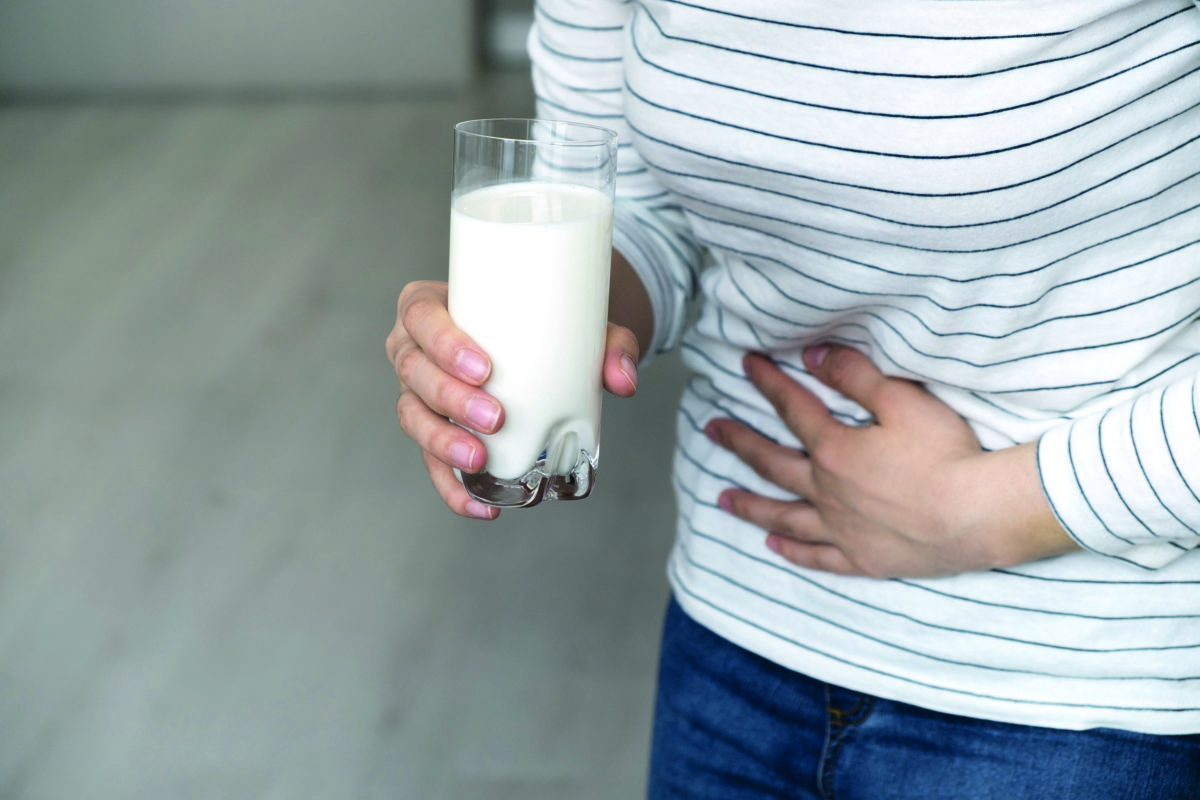When determined early in life, a cows’ milk allergy doesn’t just represent a pivotal point for the patient – it thrusts the whole family into the grips of change too. Delve into the full impact of the diagnosis through the perspectives of both the child and the parent.
My Way of Life
23-year-old Lucy studied BSc Nutrition at Cardiff Metropolitan University, and currently works at Dunbia Crosshands as a Technical Development Technologist. Since being diagnosed with a cows’ milk allergy as a child, Lucy’s diligence – coupled with medical and familial support – have helped keep the risks of flare-ups at bay. Here, she discusses her journey.
How old were you when you were first diagnosed with a cows’ milk allergy (CMA)?
I was officially diagnosed with a CMA at six months old, and was given a soya-based formula milk as an alternative to dairy-based formula milk. In addition to my allergy, I also have asthma which is controlled with inhalers, and previously suffered with eczema and hay fever as a child.
Can you describe the flare-ups and how they affected / affect you?
As an infant the main symptoms /reactions I had included projectile vomiting, inability to keep food down, skin rash and eczema.
My allergic reactions are rare as I am extra vigilant with any food I consume. If an allergic reaction does occur, the severity of the reaction depends on the amount of dairy consumed and how quickly I take my antihistamines and inhalers to counteract the reaction.
I immediately know if I have consumed even trace amounts of dairy as my tongue and the inside of my mouth will begin to tingle / itch within one-to-two minutes and my throat will start to feel tighter, causing me to wheeze.
In total I have suffered two anaphylactic reactions which both required emergency treatment at A&E and a five-day course of antihistamines and steroids to fully counteract the anaphylactic reaction. Both anaphylactic reactions were a direct result of accidental exposure / consuming dairy at a restaurant while eating out with friends and family. When compared to my milder reactions which flare-up straight away, both anaphylactic reactions were delayed by around 15-to-20 minutes after consuming the meal.
What tips and treatment were you recommended to help manage your CMA?
As I was diagnosed over 23 years ago, the best piece of advice given to my parents was for me to completely avoid all foods containing dairy, and to substitute foods with soya-based alternatives. Back in the 1990s, medical professionals advised against any exposure to dairy, whereas today there is more evidence and research to suggest that ‘food challenges’ and introducing small amounts of the offending allergen may help children grow out of the allergy and reduce sensitivity.
Do you think there is adequate awareness of CMA in the public domain?
I believe the overall awareness of CMA has increased significantly over the last decade, with more evidence-based research and a better understanding of CMA in the medical world. I think the increased awareness has helped get faster diagnoses and has explored different ways of managing CMA, including alternative foods and allergy testing.
People are generally more educated about CMA, but often mix up CMA with lactose intolerance and don’t understand the severity of CMA which I find frustrating when discussing my allergy with someone new.
Recent media coverage of high-profile cases of people suffering severe allergic reactions has dominated news outlets, and has highlighted the challenges faced by those with food allergies, including CMA.
Although some cases have tragically resulted in fatalities caused by anaphylaxis, I think it has been a real eye-opener for the general public and all food business operators regarding allergies and food safety. The dedicated work by organisations such as the Anaphylaxis Campaign has definitely improved people’s perceptions of CMA and other severe food allergies in recent years and they continue to raise awareness.
Do you have any advice as to how healthcare professionals can build on this?
I believe that schools would benefit from receiving allergy awareness presentations / training at both primary and secondary level, as more children are being diagnosed with food allergies. I think that both children and parents will feel more at ease knowing that schools are doing more to promote awareness and educate all pupils about the dangers of food allergies and how to react in an anaphylaxis emergency.
Furthermore, I think that more allergy leaflets and posters highlighting symptoms, how to use adrenaline injections, and alternative foods, should be visible in GP surgeries, hospitals and other public spaces to educate the general public.
What have been your greatest challenges?
As a child growing up with a serious food allergy it was often restricting at social events where food was involved – this included friends’ birthdays and family parties where food choices were limited. As a result, I would always bring my own alternative foods and my parents always ensured that I was never left out. I had the same issue when going on school trips abroad where my parents would ensure that all teachers were aware of my allergy and provided suitable foods.
Putting your trust in restaurant staff and their allergen procedures can be daunting and stressful at times. When eating out with family or friends I will regularly check restaurants in advance by visiting websites to check suitability and menu options for people with food allergies.
Menus are often restricting as dairy is common in a variety of dishes, although I have noticed improvements since the Food Information Regulations were enforced in 2014. Psychologically, it can be very frustrating and extremely embarrassing if I have a reaction while eating out, especially when out with friends. I hate people making a fuss and sometimes would rather leave the food establishment to avoid talking to the staff in front of other diners etc.
How have you ensured that your diet isn’t restricted by CMA?
My parents have always found dairy-free alternatives and adjusted our family meals accordingly to avoid any cross-contamination. As I have grown up with my allergy I am fully aware of the choices and alternatives available on the market for people with CMA.
Alongside the big retailers, many restaurant chains and smaller food establishments are now going the extra mile to adapt menus and recipes to cater for allergic consumers when eating outside the home. This new attitude towards food allergies and creating free-from products / menus is welcomed by individuals like myself and families of people with food allergies as it promotes more awareness and improves quality of life. I now feel more confident when eating outside the home, knowing that businesses do want to create safer allergen-free food choices.
Through the Mother’s Eyes
Lucy’s mother, Andrea, shares her determination to help her daughter experience a childhood that wasn’t dominated by her CMA diagnosis.
What symptoms prompted you to seek medical assistance for Lucy?
I had a caesarean under full anaesthetic which meant that when I came around the doctors had given my husband a bottle of Aptamil formula milk to feed Lucy with. This was the first type of milk that she was given and she vomited straight away. I breast-fed her later on, but she would continue to projectile vomit all the time and was a very colicky baby.
After a few months of breast-feeding I tried to wean her on to a different formula milk with baby rice provided in the bounty packs that we were given, however it was very challenging. She would constantly scream and spit out the baby rice straight away, which was when we noticed a type of nettle rash under her chin. We didn’t realise at the time that it was an allergic reaction to cows’ milk protein as this had not previously been flagged up by the doctors or hospital.
I went to see a pharmacist straight away who advised that we see the doctor immediately. After seeing the doctor, they prescribed a soya-based formula milk to try her on which seemed okay. We were then referred to the allergy clinic where Lucy was diagnosed with CMA at six months old. They performed skin prick tests for various allergens and concluded that she was allergic to cows’ milk, and possibly egg. We took her to the allergy clinic twice a year for checks ups but she was then discharged aged six and we never went back after that.
How did Lucy’s CMA impact the day-to-day life of the family, and the nutritional choices which you had to make?
When it came to birthdays we would always improvise by making our own birthday cakes so that they were always dairy-free and she was never left out. We would always prepare food to take out with us when out for the day because dairy-free food was not always available at cafés etc. When Lucy would stay at her grandparents’ / friends’ / relatives’ houses we would leave appropriate foods (biscuits, crisps, snacks etc.) so that she always had something to eat.
Were there any other resources or tips which were advantageous to your management of Lucy’s CMA?
The best booklet I had on dairy-free foods came with the formula milk – it included a breakdown of milk components which I used as a basis to look for suitable ingredients which was a huge help.
I found various leaflets that I would scan through for any new bits of information. I also used to keep a list of good dairy-free products that she liked and passed the list on to relatives and friends so they knew what to buy for her when she visited.
Have you noticed a transition in the CMA-appropriate products available; from then to now?
Yes, because there was hardly anything available before. In the last 12 months especially, there has been lots of focus on allergy awareness and promoting safer food.
Clearly a lot of research has gone into developing new dairy-free product ranges and restaurants are adapting their menus which is great news for us and families like us.
Coffee shops and smaller cafés seem to be doing a lot more innovation work to create cakes and sandwiches suitable for allergy sufferers which will make life a lot easier for families with allergic children when going out on day trips for example. Having somewhere local to pop in to for a coffee and cake is something that we could never do before.
To Note
The use of a soya-based formula is not currently common practice for the treatment of CMA as hydrolysed formulas are now more readily available.







